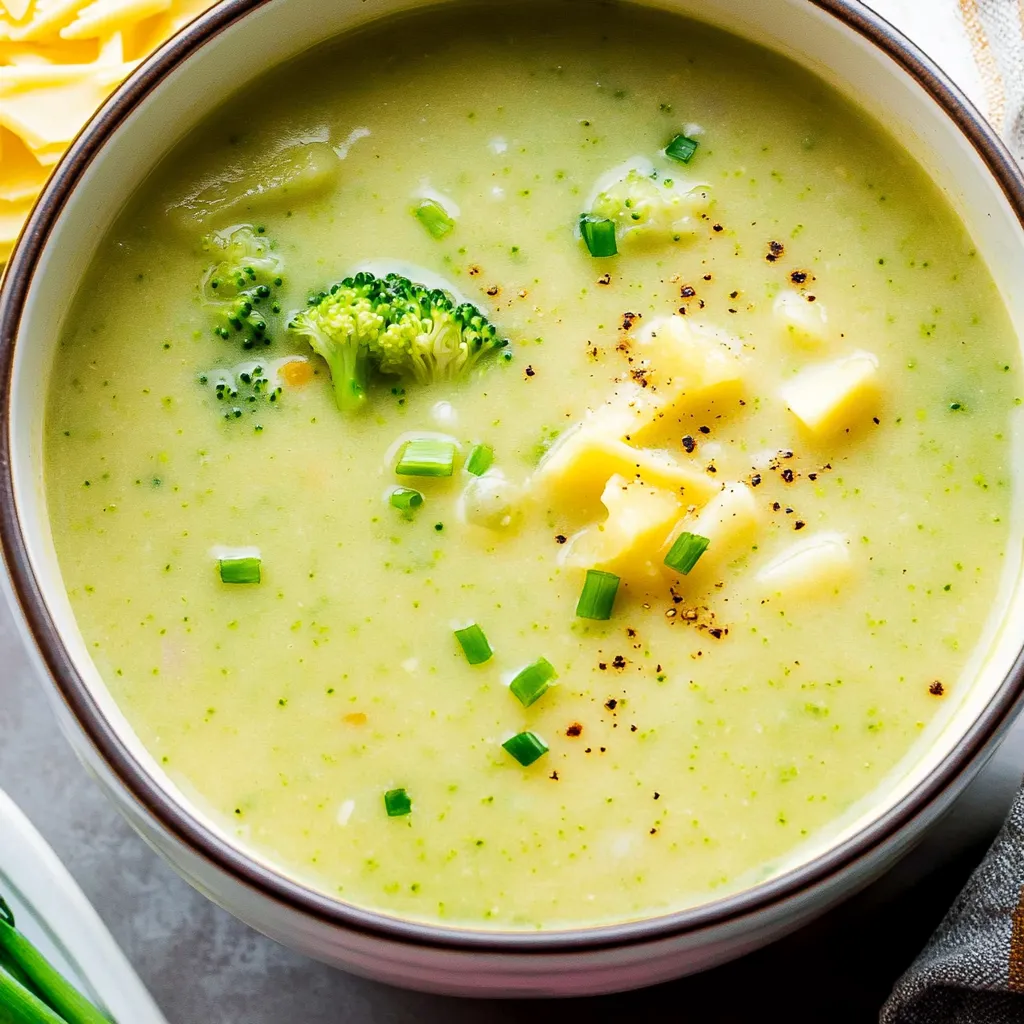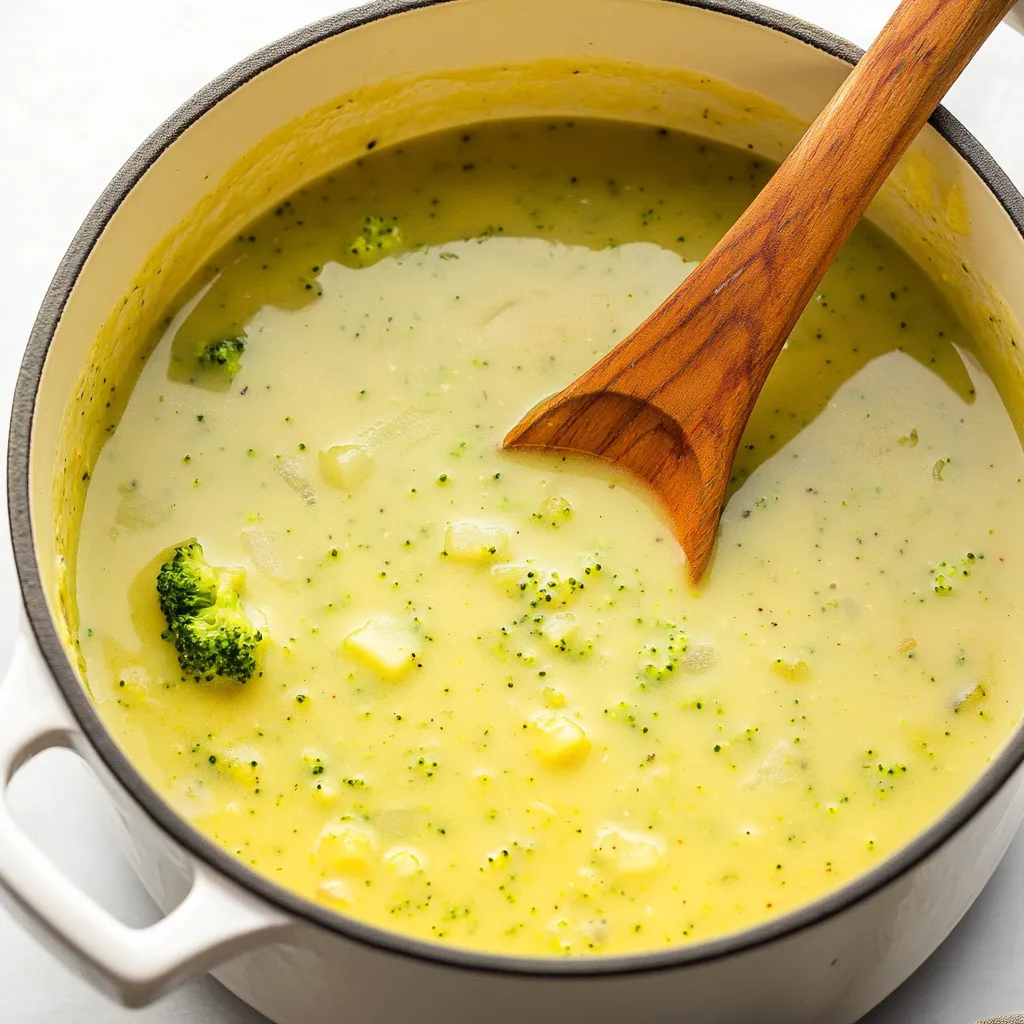 Pin it
Pin it
This vibrant broccoli cheese soup transforms everyday ingredients into a remarkably satisfying experience that delivers rich indulgence without the heaviness. Unlike traditional recipes that rely on flour and heavy cream, this version achieves its luxurious texture through a clever combination of russet potato and sharp cheddar cheese, allowing the fresh broccoli flavor to shine through rather than being masked by dairy. Each spoonful offers the perfect balance of velvety smoothness punctuated by tender broccoli florets, creating a multidimensional texture that keeps you coming back for more. The brilliant green color visually announces its nutritional virtues while the complex flavor profile—savory, cheesy, and distinctly vegetable-forward—reminds you that comfort food can be genuinely nourishing.
I spent months perfecting this recipe after numerous disappointing attempts that either masked the broccoli flavor or felt like drinking melted cheese. The breakthrough came when my husband took his first spoonful of this version and immediately declared it "the velvet of the soup world." He continued between enthusiastic bites, noting it was "all the sin without any of the guilt" and possibly "the universe's best delivery system for broccoli." The most telling endorsement came when he compared it to "a warm blanket after being outside on a long winter day" – exactly the comforting-yet-energizing quality I had been striving to achieve. Now it's our go-to meal whenever we need something that satisfies deeply while still making us feel genuinely good afterward.
Essential Ingredients
- Fresh Broccoli: The star of this show provides vibrant color, distinctive flavor, and impressive nutritional benefits. Using both the florets and stems creates a deeply satisfying broccoli experience while reducing waste. The stems actually contribute significant flavor and body to the soup base, while the florets provide both visual appeal and that satisfying texture that announces "yes, this is definitely broccoli soup."
- Russet Potato: The secret ingredient that creates luxurious creaminess without heavy cream. When cooked until tender and then blended, russet potatoes release their starch, creating a velvety texture that beautifully carries the other flavors. Their neutral flavor allows the broccoli and cheese to shine while providing substantial body.
- Sharp Cheddar Cheese: Delivers maximum flavor impact with minimum quantity needed. The pronounced tanginess and depth of aged sharp cheddar means you can use less while still achieving that satisfying cheesy quality. White cheddar specifically maintains the soup's vibrant green color rather than muddying it with orange tones.
- Butter: Creates a crucial flavor foundation that elevates the entire soup. The small amount used provides richness without heaviness, while its distinctive flavor compounds enhance the savory quality of the vegetables. Its fat-soluble flavor molecules carry throughout the soup, creating complexity that would be missing with oil alone.
- Yellow Onion: Provides essential aromatic depth that rounds out the vegetable flavors. When sautéed in butter before adding the other ingredients, onion develops sweet, caramelized notes that balance the grassier qualities of the broccoli. This foundational layer creates complexity that makes the soup taste developed rather than one-dimensional.
- Garlic: Adds pungent warmth that enhances the other flavors without dominating. Its aromatic compounds infuse the entire soup with a subtle depth that would be noticeably missing without it. When cooked gently in butter, garlic's stronger notes mellow into a gentle background savoriness.
Step-by-Step Cooking Instructions
- Prepare your broccoli for maximum flavor extraction -
- Start with 1½ pounds of fresh broccoli, reserving the stems that many recipes discard. Cut the florets into small, even pieces (about 1-inch) for consistent cooking, setting aside 2 cups to add later. Peel the tough outer layer from the stems using a vegetable peeler, then roughly chop them into ½-inch pieces. This preparation allows you to extract flavor from the entire vegetable while ensuring proper texture in the finished soup. The precise cutting also ensures even cooking without vulnerable florets becoming mushy.
- Create your aromatic flavor base -
- Melt 3 tablespoons of butter in a Dutch oven or heavy-bottomed soup pot over medium heat. Once melted, add 1 medium yellow onion, roughly chopped, and cook for 5-6 minutes until softened and translucent but not browned. Add 2 cloves of garlic (simply smashed and peeled—no need to mince since everything will be blended later) and cook for 30 seconds until fragrant. This gentle cooking releases the essential oils in the aromatics without developing bitter notes that can come from browning.
- Develop depth through layered cooking -
- Add the chopped broccoli stems and 1 medium russet potato (peeled and cut into 1-inch chunks) to the pot. Season generously with ½ teaspoon salt and ¼ teaspoon black pepper. Cook for about 5 minutes, stirring occasionally, allowing the vegetables to absorb the flavors from the butter and aromatics. This process, similar to building a risotto, creates layers of flavor that wouldn't develop if all ingredients were simply boiled together from the start.
- Create your soup base -
- Add 4 cups of water to the pot, stir to combine, and bring to a simmer. Cover and cook for 15-20 minutes, until the potato and broccoli stems are completely tender when pierced with a fork. A knife should slide into the potato with absolutely no resistance. This thorough cooking ensures that when blended, these vegetables will create the silky-smooth base that defines this soup's luxurious texture without cream.
- Incorporate your fresh florets -
- Add the reserved 2 cups of broccoli florets to the pot, cover again, and simmer for an additional 5-7 minutes until the florets are bright green and just tender. This two-stage addition of broccoli is crucial—the first batch cooks down completely to create the smooth base, while these later-added florets maintain their integrity for textural contrast and visual appeal in the finished soup.
- Transform into velvety smoothness -
- Working in batches if necessary (never fill your blender more than halfway with hot liquid), carefully transfer about half the soup, including some of the fresh florets, to a blender. Secure the lid and blend until completely smooth, about 1-2 minutes on high speed. Transfer to a heat-proof container and repeat with the remaining soup. This thorough blending creates the remarkably creamy texture that defines this soup without requiring cream or flour thickeners.
- Finish with cheese and adjustments -
- Return the blended soup to the pot over low heat. Add 4 ounces (about 1 cup) of freshly grated sharp white cheddar cheese in small handfuls, stirring after each addition until completely melted. Taste and adjust seasoning with additional salt and pepper as needed. If you prefer a more pronounced cheese flavor, add additional grated cheddar in small amounts until you reach your desired level. The soup should be velvety and rich, coating the back of a spoon but still light enough to enjoy as a full bowl.
 Pin it
Pin it
The Cruciferous Vegetable Revolution
Broccoli belongs to the remarkable family of cruciferous vegetables that includes kale, cauliflower, Brussels sprouts, and cabbage. These nutritional powerhouses derive their name from their cross-shaped flower petals and share similar nutritional profiles and health benefits.
What makes these vegetables special is their exceptional concentration of compounds called glucosinolates, which break down into bioactive compounds during cooking and digestion. These compounds have been extensively studied for their potential role in reducing inflammation and supporting cellular health.
My appreciation for broccoli deepened after learning about its impressive nutritional profile. Beyond the well-known vitamin C content (more than an orange, surprisingly), broccoli offers significant amounts of vitamin K, folate, potassium, and fiber. The stems, which many discard, actually contain as much nutrition as the florets but with a higher concentration of fiber.
The transformation that occurs when cooking broccoli properly is remarkable. Slightly undercooked, it retains a distinctive bitterness that many find off-putting. Overcooked, it becomes sulfurous and unpleasant. But cooked just right—tender but still vibrant—it develops a subtle sweetness that balances its natural grassiness perfectly.
During a cooking class I attended last year, the chef described broccoli as "the vegetable that suffers most from bad reputation due to poor preparation." This soup, with its careful cooking method and thoughtful flavor building, showcases broccoli at its absolute best.
The Science of Creamy Soup Without Cream
Creating a luxuriously creamy soup without dairy typically requires understanding food science principles that professional chefs employ. The breakthrough in this recipe comes from utilizing the natural starches in potatoes as an emulsifier and thickener.
When potatoes cook, their starch granules absorb water and burst, releasing amylose and amylopectin—the two types of starch molecules that give potatoes their thickening power. When blended, these starches create a remarkably silky texture that mimics the mouthfeel of cream but with a lighter finish.
The second scientific principle at work is emulsification—the stable suspension of fat in liquid. Traditionally, flour and butter (a roux) or cream provide this function in soup. In this recipe, the potato starch molecules perform this role, surrounding the fat molecules from the butter and cheese and preventing them from separating from the water-based components.
I discovered this technique while trying to create recipes for a friend with dairy sensitivity. What began as an accommodation became my preferred method for creating creamy soups of all kinds. The potato not only creates superior texture but also doesn't mask the featured vegetable's flavor the way heavy cream can.
The blending process itself is crucial for proper emulsification. High-speed blending physically breaks down cell walls in the vegetables and creates the friction necessary to form the emulsion. This is why a powerful blender produces noticeably better results than an immersion blender for this style of soup.
I discovered through experimentation that the order of operations significantly impacts the final flavor. Adding the broccoli stems with the potatoes rather than later with the florets allows them to fully break down and release their flavor into the base. This seemingly small adjustment resulted in noticeably enhanced broccoli flavor throughout the entire soup rather than just in the visible florets.
The most valuable insight I gained through multiple test batches was the impact of cooking temperature on flavor development. My early attempts used higher heat to speed the process, but keeping the heat at medium or lower prevents any browning of the vegetables. This careful temperature control maintains the bright green color and clean flavor that makes this soup so remarkable.
This broccoli cheese soup represents what I love most about thoughtful cooking—how understanding ingredients and techniques allows us to create something that satisfies deeply without compromising nutrition. It reminds us that "comfort food" doesn't have to leave us feeling weighted down, and that classic combinations can be reimagined in ways that actually improve upon tradition. Whether served as a light meal with crusty bread or as a starter for a special dinner, this soup demonstrates that careful attention to detail can transform simple ingredients into something truly extraordinary.
Frequently Asked Questions
- → Can I make this soup ahead of time?
- Yes! This soup keeps well in the refrigerator for up to 4 days. The color may darken slightly but the flavor remains delicious.
- → Can I freeze broccoli cheese soup?
- Yes, you can freeze this soup in airtight containers for up to 3 months. Thaw overnight in the refrigerator and reheat gently on the stovetop.
- → How can I make this soup dairy-free?
- Replace butter with olive oil and blend in soaked cashews, nutritional yeast, lemon juice, apple cider vinegar and a bit of Dijon mustard instead of cheese.
- → Why use potato in broccoli cheese soup?
- The potato adds natural creaminess without using heavy cream or flour, making the soup naturally gluten-free with a smoother texture.
- → Can I use frozen broccoli for this soup?
- Fresh broccoli works best, but in a pinch, frozen will work. Skip the separate cooking times and add all the broccoli at once since frozen broccoli is already blanched.
